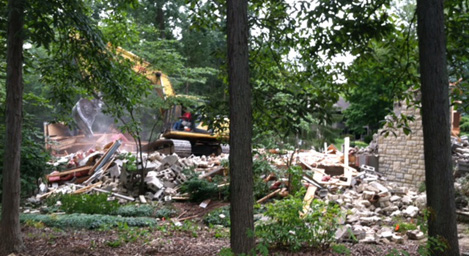
Polish or Demolish? How To Decide Whether To Renovate or Tear Down a House
If you’re thinking of building a new home, you’re probably looking at empty property – a lot in a subdivision, or like many of my clients, a larger bit of land further out.
Or maybe you’re buying an existing house with the intent to renovate it and make it your home.
But what if you’re somewhere in between – you’re building a new house, but the property you’re thinking of buying already has a house on it. When does it make sense to fix it up, and when does it make sense to tear down a house and start over?
Tear-downs happen all the time – I’ve been involved in more than a few with my clients. Sometimes the house is torn down, and sometimes it’s purposefully burned down (that’s another story, read about burning down a house here).
Personally, I’d rather keep and remodel a house whenever we can, especially when the house is a part of a neighborhood of character.
But that’s not always possible. Here are some of the things I’ve learned – some technical, some emotional – that might you help you decide when to “polish” and when to “demolish”.
Look at the Character of the Neighborhood and Check Property Values
Demolishing a house only makes sense financially if home prices in the area are stable or on the upswing. Building the most expensive house on the street isn’t a great idea in an area that’s going downhill. If that’s the neighborhood you really want to be in, though, better to renovate than build new.
But in a steady or growing area, it might be the right thing to do. A couple of the houses I’ve helped tear down were the ugly ducklings of the neighborhood, and I think we did everyone a favor by replacing them with something that fit the area better, and added value.
The opposite is true, too. When a house already fits a neighborhood well, when it’s an essential part of the architectural fabric, it’s not a candidate for demolition unless it’s literally falling down (and maybe not even then). You have responsibilities to the community that extend beyond your property lines.
Investigate the House’s Structural Integrity
You’ll probably need some engineering help to figure this one out. The older a home is, the less likely it is that the structure was designed to modern codes. Same’s true for houses “way out” in the country, where codes aren’t always enforced or maybe don’t exist at all.
A house with a sub-standard structure can be expensive to update. Assuming you don’t want a creaky, squeaky, rattling, bouncing-floors home, you’ll likely spend money on beefing up the floors, walls, and roof.
And once you start fiddling with the guts of the house, you’ll probably need to bring all of it up to current codes. That can be the beginning of the proverbial snowball that eventually eats up much of your renovation budget.
Review the cost of major structural repairs against new home construction – getting the house you want will be more difficult if you start off pouring tens of thousands into the structure, before you get to the fun stuff.
Watch Out for Questionable Foundations and Basements
Three of the demolition projects I’ve been involved with had insurmountable foundation issues. In one, there were a large number of settling cracks in the foundation walls, indicating problems with drainage and/or soil under the house.
It wasn’t a very big house, so it was on the polish/demolish bubble anyway, but the idea of excavating around the entire house to reinforce the walls, fix the settling, and install drainage and waterproofing pushed it solidly into the “demo” category.
The second one didn’t have cracked walls, but the foundation had other problems. The walls were narrow and unreinforced, which meant the second story my clients wanted to build on top of it would have required expensive foundation modifications.
Fixing bad or unsuitable foundations can be one of the most expensive things you do to a house. Think “demolish” if this is the case with yours.
Have There Been any Previous Renovations?
Old houses often have a long history of renovations, additions, and repairs that weren’t done as well as the original.
Sometimes those alterations improve the house, but they frequently detract from it. Too often, I find solid older homes that have been “renovated” with astonishingly unsafe framing, cheap finishes, poorly designed additions that don’t match the original structure, and way too much “DIY” work.
You’re going to have to tear out and replace the bad work anyway. If the house is otherwise sound, this won’t be a big problem – just add it to the list of things you’re going to polish up.
For poorly-built or poorly-designed additions, think about a partial demolition. I’ve been involved in a couple of projects where the overall renovation project actually made the house a little smaller.
Headroom Issues Can Be Expensive to Fix
It’s pretty typical in homes these days to make ceilings at least nine feet tall, but that’s not nearly as common in older homes. Low ceilings are rarely worth raising – you’ll be impacting the structure of course, but also the wall finishes inside and out. You’ll be replacing or extending all the wiring, plumbing, and HVAC that serves the second floor, and you’ll be putting in a new stair.
If the basement’s too low the problems are even bigger – lowering a basement floor is almost impossible, and adding to the top of a basement wall means lifting the entire house up.
That’s not a terrible idea if the house is unique and/or historic, and you’ll have my thanks for keeping the character of it intact. But it’s not easy, or cheap.
Too-low ceilings should definitely be on your list of possible reasons to tear down a house.
Floor Level Changes Might Not be Fixable At All
This was a contributing factor in a project I designed a few years back. The house was divided in half by a level change of five steps, or about three and a half feet. But my empty-nester clients wanted all the living spaces and the master bedroom suite on the same floor, which the level change made just about impossible to accommodate.
Believe me, we tried every imaginable arrangement of spaces to minimize the impact of that level change on the house. In the end, though, the only way they could get the house they wanted was to clear the lot and start over.
What are the Zoning and Building Restrictions on the Property?
Out in the country you won’t many regulations controlling where you can add onto a house or where you can build a new one.
But municipalities are a different story. Most have setback requirements that limit the area where you can build, which can make it hard to expand an existing house the way you want.
In the older neighborhoods where I often work, some of the homes were built over the setback lines, or stricter setback lines were established many years later. The location of those houses were “grandfathered in”; you can keep the existing house there but you can’t expand it.
And if you tear the grandfathered house down, you can’t rebuild in the same location.
Is There a Neighborhood Design Review Requirement?
In many neighborhoods, proposed new homes are subject to design review. The existing house might not be exactly what you wanted, but if you tear it down and start over, are you willing to design your new home to meet the neighborhood guidelines? (Read more about design review here).
If review guidelines are strict you might consider keeping the house and renovating the interior, keeping the exterior intact so you won’t run afoul of the review board.
In Historic neighborhoods, design guidelines often make getting a demolition permit extremely difficult or impossible – another good reason to work with the home that’s already there.
Compare the Lot Cost to House Cost
Some of the reasons above boil down to costs – will it cost more to renovate or to build new? Does spending money on renovation make sense in your neighborhood? Those are complicated questions that you won’t answer quickly.
There’s one quick comparison you can do, however, if your goal is to build a new home – how does the cost of buying an empty lot compare to buying a lot with a house on it, regardless of the condition of the house?
Say for example a new lot in a new subdivision costs $150,000 and an existing house in an older neighborhood costs $250,000. Is the $100k premium worth it to be in an established area, with mature trees, and little chance of future construction work disrupting your life?
The other option will save you $100k, but you’ll be living with the uncertainty of the neighborhood’s future, trees that won’t be mature until you sell your house, and years and years of construction noise and dust.
So Should You Polish or Demolish?
My clients have all heard me say that every project’s unique, and nowhere is that more true than choosing whether to demolish an existing house. It’s a decision you can’t make only on cost, or only on emotion. All of the “practical” factors might add up to “demolish”, but you polish the house anyway because, well, you’re in love with it.
Then again, a charming house might be too far gone to reasonably repair.
Either way, a thorough examination using the criteria above will help you make the right decision for you and your family.




When I found the contractor that I wanted to use after interviewing 6. Some of them could not make my intended plan work at all …they had their own ideas of what my house should be like. You would be surprised how many really did not listen to me.
Originally I had worked with a commercial architect who was a friend of the family… just to kind of get an idea of how I wanted things… so I had something to give to the various contractors… so we had something to talk about without going through a process and then finding out that they weren’t the contractor I wanted.
Of all the contractors I talked to…. the company that I chose was the only one that would entertain the idea of demolishing and starting over.
We talked about the option of demolishing my house or remodeling it turned out my house had a lot of structural issues more than even we realized. And those became more evident when they were demolishing So it was actually a great decision to demolish.
Probably the biggest point was that I wanted this new house to be my last house … that I could grow old in with everything on one floor nothing that I had to go to the basement for. Even though I do have a partial basement and several crawl spaces that join it… under the house. I wanted larger functioning comfortable rooms and arrange them very differently than the original House. I have a mechanical room main floor.
I had siding put on my house instead of brick to make it look much more like my neighbor’s houses. Original house was built in 1949. My house is sage green with white trim.
My house doubled in size …originally 1300 square feet. As soon as I get this current house paid for in another six years. I’m going to add on my final addition and I’m going to have an indoor exercise pool. With my arthritis some days it’s very difficult to walk and it really doesn’t matter how much I spend I can’t take it with me.
I’m an only child whoever gets this house someday is going to have one heck of a functioning comfortable House. And yes I am already well over the price of my neighborhood.. but I’ve already lived here for 21 years before we demolished the old house. My neighbors are good people they’re solid people not snobby not keeping up with the Joneses just a great neighbor.
I subscribed to your emails and have gotten good ideas lots information and I thank you. I’d like to continue to still get emails from you.
Conda – wow, you were lucky you decided to demolish the house! Good thing you didn’t get deep into a renovation only to find out the structure had major issues.
I hope you keep reading – thank you for being a subscriber!
I like that you talked about how sometimes it would be best to demolish a house if the rest of the neighborhood is really nice. I have been trying to decide what to do with my grandparents’ old house. I can see how it might be best to demolish and rebuild because the rest of the neighborhood is made out of all new homes.
Thanks for this article, my wife and I found it very helpful. We’re thinking about purchasing a home in Southern California that’s in very bad shape, but on a beautiful lot in a great neighborhood. After reading your second to last paragraph, demolition sounds like a great idea. Thanks!
I’m thinking of buying a hullled out
house in poor condition,sits on
an acre,current county assessment
Is 33k land,77k . I’ve offered home
owner 56k. Thinking about a tear
down and building a carriage house with plenty of garage space.
Is this a smart way to go?House
is located in the country. Thanks,
Vaden Robinson Jr. Charles City
Va.,text 804 347-6365.
I live in a neighborhood that is 13 years into a 20 year master plan. So my home has appreciated since I originally purchased it. I am trying to decide if I should continue renovating a 100 year old home (partially replaced roof and floors, thus far) or demolish and start over. Two fireplaces must be rebuilt, siding and insulation must be replaced, and I found a new leak in the basement today. Before I continue repairing this home, it’s time to bring in an architect and engineer to help me assess my next move.
Your article is timely, and I am looking forward to more. Thank you.
It’s the “basement leak” comment that got my attention – usually fixable, but also usually a sign of things to come, as in never-ending repair expenses. So your house is 1920’s vintage (lots of great little homes built in that decade) in a neighborhood of (much) newer homes, have I got that right? Maybe the key question is whether your house can appreciate at all, if the adjacent homes are new, and I assume, very different? The oddball house in a neighborhood – even if it’s a nice Period home – isn’t often a recipe for future value.
We’re considering a teardown/rebuild on our own lot. Our home is too small for our family & 120 years old, with major structural/foundation issues that would cost $30-40K to address before we could renovate & add on. It also has other “old house” issues: some knob & tube wiring, poor insulation & ventilation, lack of storage & bathrooms. The cost of fixing all this & adding on is pushing up against building new. Buying a bigger house in our area would also be an issue because they are also older homes with their own structural/foundation issues and inefficient layouts.
Our fully developed urban neighborhood has houses around the same age, but major renos are happening & even other teardowns nearby in our school district. Nearby suburbs are well into a teardown boom. We love the area & don’t want to change schools for the kids.
Very few actual lots come up for sale. We found 2 recent sales of rundown houses on similar lots and had discussions with an appraiser & a house flipper we know. We have good evidence that our lot is worth almost exactly what we owe on our house and also what a comparable property to tear down in our area would cost. We’d still have teardown costs but no real estate commissions.
We love the idea of staying where are for at least 10 years & having all new systems & a design/layout we choose. We also don’t want a generic house without any character & want anything we do to fit in with the area. We wouldn’t be overbuilding for the neighborhood in size/height/footprint, but it looks like our total investment could exceed the highest recent sales in our immediate area by $100K. Pump the brakes?
If you’re mostly worried about the $100k there’s not much you can do about that – construction costs are rising rapidly and it will just get more expensive the longer you wait. Other than that, it sounds like you’ve already thought this through thoroughly, not sure what I could add!
Thanks for the quick reply. I also appreciate the design review board post. A concept review is a great idea.